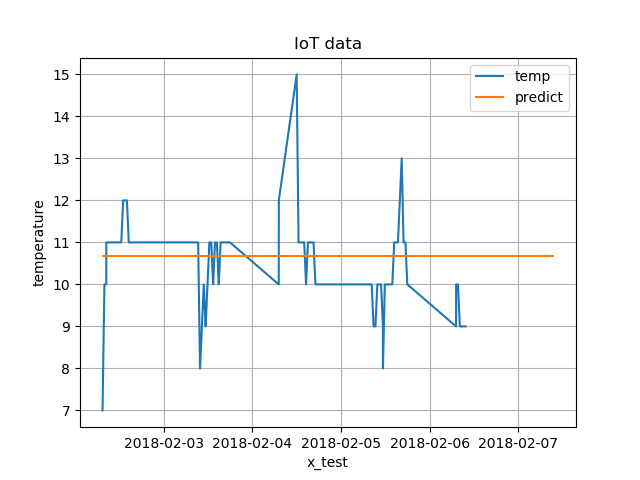ディープラーニングで、数値系予測 python版
index:
概要
ディープラーニングの、予測系問題として、温度値の数値予測を検討してみました。
python版で、フレームワークは使用しておりません。
設計については、書籍を参考にしていますので。オリジナル仕様ではありません。
参考の書籍
ゼロから作るDeep Learning /オライリー・ジャパン
ISBN978-4-87311-758-4
https://www.oreilly.co.jp/books/9784873117584/
=>基本的な部分かもしれませんが、勉強になりました。
コード
上記書籍の4章の、比較的シンプルな例を参考にしています
一部のコードのみですが、
興味のある方は、書籍を参考下さい(有償ですが。)
・train.py
学習、パラメータ保存
モデル、ニューロンの数
入力 : 1
隠れ層: 10
出力層 : 1
=> csvファイルから、データ読み込み、学習
# -*- coding: utf-8 -*- # train/学習処理。結果ファイル保存。 # TwoLayerNet を参考に、3層ネットワーク利用 # 学習 >パラメータ保存 import numpy as np import pandas as pd from matplotlib import pyplot as plt from simple_net import SimpleNet from util_dt import * import time # if __name__ == '__main__': # 学習データ rdDim = pd.read_csv("sensors.csv", names=('id', 'temp', 'time') ) fDim = rdDim["temp"] #print(fDim[:10] ) #quit() y_train = np.array(fDim, dtype = np.float32).reshape(len(fDim),1) x_train = conv_obj_dtArr(rdDim["time"] ) # aa = add_date_arr(rdDim, 24 * 10 ) #add N day x_test_pred = add_date_arr(rdDim["time"], 24 * 1 ) n_train = int(len(x_train) * 0.1 ) x_test = x_train[ n_train : ] y_test = y_train[ n_train : ] # x_test_pred =get_pred_dat(x_test, 30 ) N= len(x_train) N_test =len(x_test ) num_max_y =100 y_train =y_train / num_max_y y_test =y_test / num_max_y print(x_train.shape, y_train.shape ) print(x_test.shape , y_test.shape ) #quit() # network = SimpleNet(input_size=1 , hidden_size=10, output_size=1 ) iters_num = 3000 # 繰り返しの回数を適宜設定する train_size = x_train.shape[0] print( train_size ) # global_start_time = time.time() # batch_size = 100 batch_size = 32 learning_rate = 0.1 train_loss_list = [] train_acc_list = [] test_acc_list = [] # iter_per_epoch = max(train_size / batch_size, 1) iter_per_epoch =200 #print(iter_per_epoch) #quit() for i in range(iters_num): batch_mask = np.random.choice(train_size, batch_size) x_batch = x_train[batch_mask] t_batch = y_train[batch_mask] # 勾配の計算 grad = network.gradient(x_batch, t_batch) # パラメータの更新 for key in ('W1', 'b1', 'W2', 'b2'): network.params[key] -= learning_rate * grad[key] loss = network.loss(x_batch, t_batch) train_loss_list.append(loss) if i % iter_per_epoch == 0: train_acc = network.accuracy(x_train, y_train) test_acc = network.accuracy(x_test, y_test) train_acc_list.append(train_acc) test_acc_list.append(test_acc) print("i=" +str(i) + ", train acc, test acc | " + str(train_acc) + ", " + str(test_acc) + " , loss=" +str(loss) ) print ('time : ', time.time() - global_start_time) #print("train acc, test acc | " + str(train_acc) + ", " + str(test_acc)) #pred train_acc = network.accuracy(x_train, y_train) test_acc = network.accuracy(x_test, y_test) # print("train acc, test acc | " + str(train_acc) + ", " + str(test_acc) + " , loss=" +str(loss) ) print ('time : ', time.time() - global_start_time) # # パラメータの保存 network.save_params("params.pkl") print("Saved Network Parameters!")
・評価
predict.py
# -*- coding: utf-8 -*- # 評価 # import numpy as np import pandas as pd from matplotlib import pyplot as plt from simple_net import SimpleNet from util_dt import * import time import pickle # if __name__ == '__main__': # 学習データ global_start_time = time.time() # rdDim = pd.read_csv("sensors.csv", names=('id', 'temp', 'time') ) fDim = rdDim["temp"] y_train = np.array(fDim, dtype = np.float32).reshape(len(fDim),1) x_train = conv_obj_dtArr(rdDim["time"] ) #add N day x_test_pred = add_date_arr(rdDim["time"], 24 * 1 ) n_train = int(len(x_train) * 0.1 ) x_test = x_train[ n_train : ] y_test = y_train[ n_train : ] N= len(x_train) N_test =len(x_test ) num_max_y =100 y_train =y_train / num_max_y y_test =y_test / num_max_y print(x_train.shape, y_train.shape ) print(x_test.shape , y_test.shape ) # load network = SimpleNet(input_size=1 , hidden_size=10, output_size=1 ) network.load_params("params.pkl" ) #print( network.params["W1"] ) #pred train_acc = network.accuracy(x_train, y_train) test_acc = network.accuracy(x_test, y_test) # print("train acc, test acc | " + str(train_acc) + ", " + str(test_acc) ) # x_test_dt= conv_num_date(x_test_pred ) x_train_dt= conv_num_date(x_train ) #print(x_test_dt.shape ) y_val = network.predict(x_test_pred ) y_train = y_train * num_max_y y_val = y_val * num_max_y print ('time : ', time.time() - global_start_time) #print(y_val[:10] ) #print(x_test_dt[:10] ) #quit() #plt plt.plot(x_train_dt, y_train, label = "temp") plt.plot(x_test_dt , y_val , label = "predict") plt.legend() plt.grid(True) plt.title("IoT data") plt.xlabel("x_test") plt.ylabel("temperature") plt.show()
実行ログ
・学習
1517910051.0 ((106, 1), (106, 1)) ((96, 1), (96, 1)) 106 i=0, train acc, test acc | 1.0, 1.0 , loss=0.04343470078904482 ('time : ', 0.004988908767700195) i=200, train acc, test acc | 1.0, 1.0 , loss=0.0019784747520252997 ('time : ', 0.037760019302368164) i=400, train acc, test acc | 1.0, 1.0 , loss=0.0017000861910257533 ('time : ', 0.06999611854553223) i=600, train acc, test acc | 1.0, 1.0 , loss=0.0018671478595782493 ('time : ', 0.10175895690917969) i=800, train acc, test acc | 1.0, 1.0 , loss=0.0025957290751811744 ('time : ', 0.13359308242797852) i=1000, train acc, test acc | 1.0, 1.0 , loss=0.0021469629579090287 ('time : ', 0.1651439666748047) i=1200, train acc, test acc | 1.0, 1.0 , loss=0.0021951411047292646 ('time : ', 0.19913506507873535) i=1400, train acc, test acc | 1.0, 1.0 , loss=0.0017905553515502502 ('time : ', 0.23587608337402344) i=1600, train acc, test acc | 1.0, 1.0 , loss=0.003246984949423655 ('time : ', 0.26787710189819336) i=1800, train acc, test acc | 1.0, 1.0 , loss=0.0008185550884545171 ('time : ', 0.29988908767700195) i=2000, train acc, test acc | 1.0, 1.0 , loss=0.0007422158728507941 ('time : ', 0.3315908908843994) i=2200, train acc, test acc | 1.0, 1.0 , loss=0.002144580155490773 ('time : ', 0.36358094215393066) i=2400, train acc, test acc | 1.0, 1.0 , loss=0.0006523045260240316 ('time : ', 0.39658689498901367) i=2600, train acc, test acc | 1.0, 1.0 , loss=0.0007984398868557556 ('time : ', 0.43489599227905273) i=2800, train acc, test acc | 1.0, 1.0 , loss=0.0017546652891529933 ('time : ', 0.4676520824432373) train acc, test acc | 1.0, 1.0 , loss=0.0014729059300481405 ('time : ', 0.4995899200439453) Saved Network Parameters!
・評価
1517910051.0 ((106, 1), (106, 1)) ((96, 1), (96, 1)) train acc, test acc | 1.0, 1.0 ('time : ', 0.013662099838256836)

